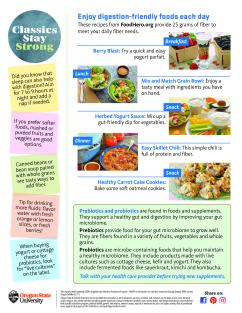Focus on Digestion

Digestion is the process of breaking food into nutrients the body can use for energy, growth and repair. Removing unused liquid and solid material is also part of the process. Our digestive system runs from our mouth to the end of our colon.
Did you know? Your large intestine (also called the gut) is home to trillions of microorganisms known as the gut microbiome. Your microbiome helps with digestion by making some vitamins, blocking the growth of harmful microbes and helping your immune system.
The Digestive System
What does healthy digestion look like?
- Regular and pain-free bowel movements.
- Minimal gas, bloating, constipation or diarrhea.
- Steady energy through the day.
How can digestion change with age?
- Chewing and swallowing food can be more challenging with less saliva or dental problems.
- Breaking down food may be more difficult with reduced stomach acid.
- Some medications can affect appetite and digestion.
Daily Actions for Healthy Digestion
Eat foods with fiber:
- to slow digestion in your stomach for stable blood sugar.
- to promote regularity and prevent constipation.
- to feed helpful bacteria in your gut for a strong immune system.
Drink fluids:
- to break food down into nutrients.
- to move food along the digestive system.
- to create a soft stool for regular bowel movements.
Include Physical Activity:
- to stretch and strengthen the muscles of digestion.
- to move food through your colon for regular bowel movements.
- to increase the types and numbers of helpful microbes in your gut.
Enjoy digestion-friendly foods each day
These recipes from FoodHero.org provide 25 grams of fiber to meet your daily fiber needs.
Breakfast: Berry Blast: Try a quick and easy yogurt parfait
Lunch: Mix and Match Grain Bowl: Enjoy a tasty meal with ingredients you have on hand
Snack: Herbed Yogurt Sauce: Mix up a gut-friendly dip for vegetables
Dinner: Easy Skillet Chili: This simple chili is full of protein and fiber
Snack: Healthy Carrot Cake Cookies: Bake some soft oatmeal cookies
Classics Stay Strong
- Did you know that sleep can also help with digestion? Aim for 7 to 9 hours at night and add a nap if needed.
- If you prefer softer foods, mashed or puréed fruits and veggies are good options.
- Canned beans or bean soup paired with whole grains are tasty ways to add fiber.
- Tip for drinking more fluids: flavor water with fresh orange or lemon slices, or fresh berries!
- When buying yogurt or cottage cheese for probiotics, look for “live cultures” on the label.
Prebiotics and Probiotics
Prebiotics and Probiotics are found in foods and supplements. They support a healthy gut and digestion by improving your gut microbiome.
- Prebiotics provide food for your gut microbiome to grow well. They are fibers found in a variety of fruits, vegetables and whole grains.
- Probiotics are microbe-containing foods that help you maintain a healthy microbiome. They include products made with live cultures such as cottage cheese, kefir and yogurt. They also include fermented foods like sauerkraut, kimchi and kombucha.
Talk with your health care provider before trying new supplements.




